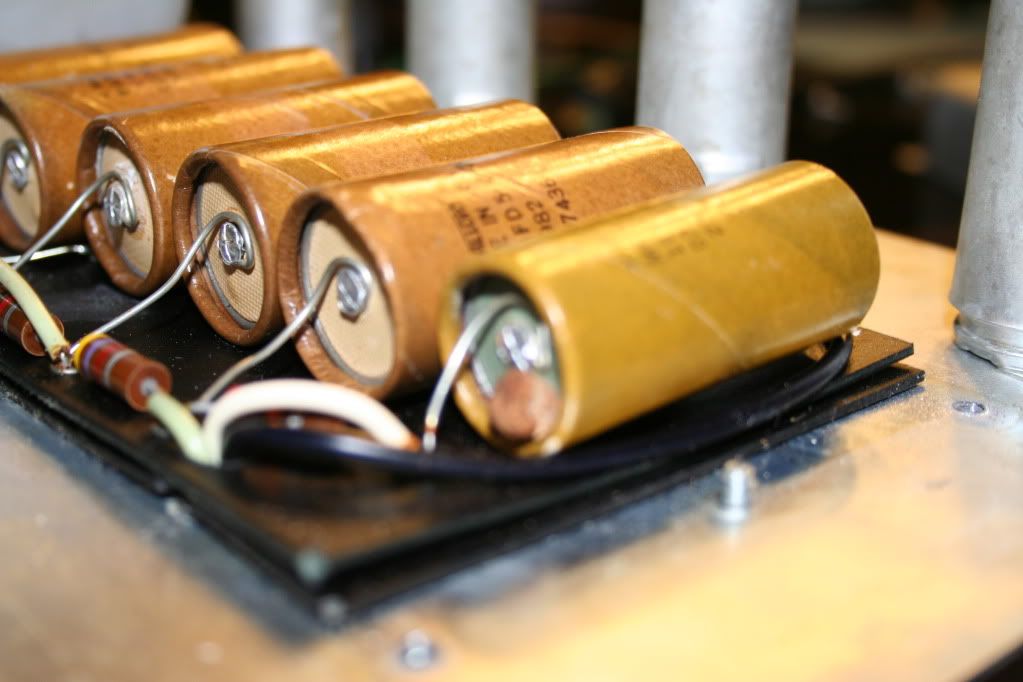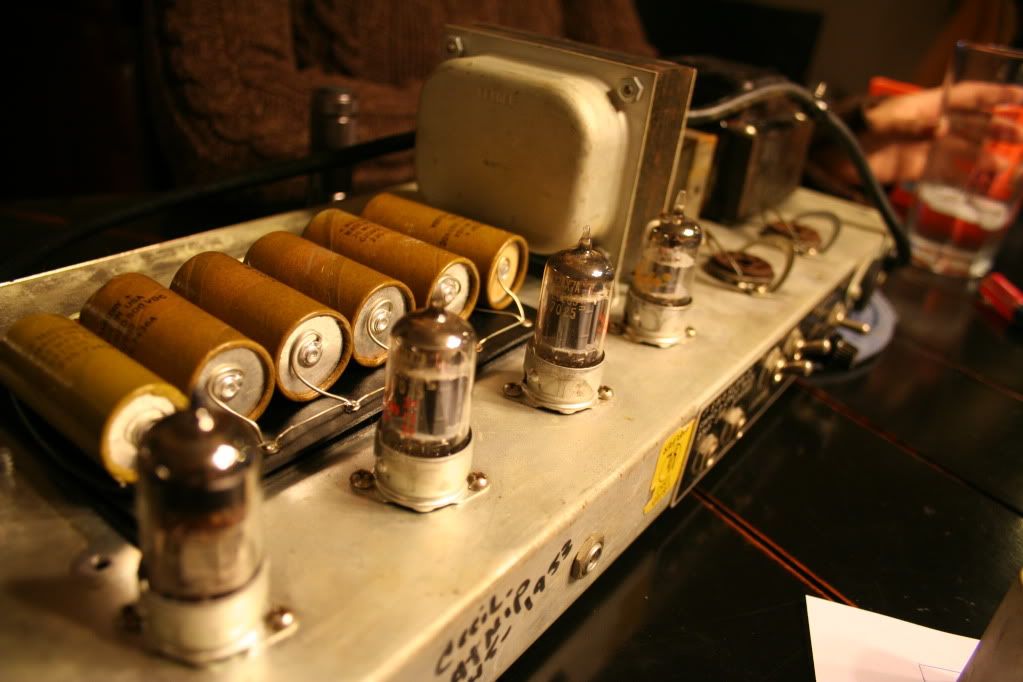Page 2 of 2
Posted: Sun Jan 31, 2010 3:46 pm
by cobascis
I think I'm going to replace the power cord and stop there. Over at the Vintage Amps forum most guys told me to take it to t tech, as I'd probably die re capping it... They also said that caps were eventualyl going to go in a messy fashion. 'REPLACE BEFORE YOU PLAY'.
meh.
Posted: Sun Jan 31, 2010 4:24 pm
by Haze
i just got done rocking out to weezer smashing my bassman with a lpb-1 and IM STILL ALIVE, and my caps are worse off than yours. Plus i LIKE TO PUT MY AMP ON 10. Most of those 'Vintage Amp forum' guys would rather get a $500 attenuator
its out of focus, but here is my leeeeky cap

and since its relevant

that being said it hums like a mofo after 5 on the master and one of the tube sockets needs cleaning so it makes loud rattling noises from the vibrations occasionally.
CAN you still play it? sure, why not.
SHOULD you? for the sake of the amp it'd be best to hold off for now until it is serviced
Posted: Sun Jan 31, 2010 4:32 pm
by cobascis
whats the worst case scenario? exploded caps?
Posted: Sun Jan 31, 2010 4:42 pm
by Haze
"If you wire a capacitor in backwards there is a very good chance that it will explode in your face."
not sure if using them well past their recommended life-span will make them assplode but for safety reasons i'll say yes, it will
CHANGE EM OUT
if you decide to poke around again, check this out first
http://tubenewbie.com/discharge_capacitors.html
Posted: Sun Jan 31, 2010 7:36 pm
by omari
i'm surprised no one's mentioned that you should have a matched pair of power tubes. i recommend tubestore.com if you haven't ordered tubes already.
Posted: Sun Jan 31, 2010 7:45 pm
by James
I got my bassman with those caps replaced to Sprague Atoms. They seem to be the standard high quality replacement and they're certainly affordable.

Posted: Sun Jan 31, 2010 10:00 pm
by cobascis
Could someone send a list of what caps I need? I think it would be cheaper if I gave the tech the caps after ordering some.
Vintageamps forum said 'don't run the amp, it's a time bomb waiting to explode..'
How?
Also does anyone have a schematic or picture of a correctly modified 3 prong power cord? I'd assume that the convenience outlet is bypassed entirely.
Posted: Sun Jan 31, 2010 10:24 pm
by Sloan
The caps value should be on the caps themselves, they are usually shown as MFD which is the same as uF. Go to
http://www.tubesandmore.com and you can get prices/order them. I can't see anything noticeably wrong with your caps from the pictures you posted. If your hearing hum with no instrument plugged in, then the caps are probably to blame.
Posted: Sun Jan 31, 2010 10:24 pm
by cobascis
" The three prong cord should be wired as follows, green ground to a secure lug, I usually use one of the PT mounting screws. White (neutral) from three prong to either of the black wires (primaries) coming from the PT. Disconnect and remove any original wires to the power switch, polarity switch and convenience outlet. Wire the remaining black wire (hot) coming from the line cord to the power switch, then out of the power switch to the fuse, then out of the fuse and connect to the other black lead (primary) going into the PT."
Can you guys make sense of this?
Posted: Sun Jan 31, 2010 10:28 pm
by James
Are you sure you should be doing this? It isn't the same as doing maintainence on a guitar. It's potentially lethal to your amp or, worse, to you.
Posted: Sun Jan 31, 2010 11:03 pm
by cobascis
It's 3 solder points. If I wear rubber gloves, keep one hand in pocket, and don't touch anything except with the iron I should be fine.
(?)
If I ebay my JBL D120f I think I'll have enough to pay for most of the recap and what not.
Posted: Sun Jan 31, 2010 11:04 pm
by paul_
cobascis wrote:" The three prong cord should be wired as follows, green ground to a secure lug, I usually use one of the PT mounting screws. White (neutral) from three prong to either of the black wires (primaries) coming from the PT. Disconnect and remove any original wires to the power switch, polarity switch and convenience outlet. Wire the remaining black wire (hot) coming from the line cord to the power switch, then out of the power switch to the fuse, then out of the fuse and connect to the other black lead (primary) going into the PT."
Can you guys make sense of this?
PT means power transformer.
Stop working on the amp immediately if you don't understand the rest and just have someone else do it. There was a kid called Jagon who wouldn't stop screwing around in the back of an old Magnatone he found in his attic despite our protests, then a short time previous his neighbor's house burned down.
Posted: Sun Jan 31, 2010 11:26 pm
by cobascis
Yeah i think ill sell whatever I don't need and tell parents ill die if I don't get it fixed, etc.
Posted: Mon Feb 01, 2010 2:24 am
by cobascis
Huh. I've been thinking.
Do you guys think it would be a good idea to do this?
eBay the Bassman. Get at least $300.
Profit.
Buy a different Bassman with new caps (or one cheap enough so I can afford new caps).
This is a last resort if I can't get money together before next major gig/recording session.
Opinions?
Posted: Mon Feb 01, 2010 2:32 am
by James
Just get this one sorted.
Posted: Mon Feb 01, 2010 9:29 am
by robert(original)
word, just stop fucking around and get it serviced.
sell crack for a week, ass or the drug, whatever, make ends meet, and get some cash.
Posted: Mon Feb 01, 2010 1:32 pm
by NickS
cobascis wrote:Vintageamps forum said 'don't run the amp, it's a time bomb waiting to explode..'
How?
If the electrolytic caps have not been on load for several years, they can depolarise and need to be re-polarised, a.k.a. "re-forming". Until they're re-formed they can have quite high internal resistance - ESR (Effective Series Resistance). That can generate a lot of internal heat and end up, in the worst case, with a burst of boiling electrolyte in the face (similar to running one reversed). Modern electrolytics normally have a vent or designed-in weakness that ruptures when the pressure gets too high, to prevent the cap going off like a bomb. Here's how axial caps fail these days:

To re-form caps, amp techs often use a variac to bring the input voltage up slowly. On my valve kit that hasn't been run for a couple of years I tend to switch it on briefly (all my old valve stuff has solid state rectifiers at the moment) and then leave it off for a while, repeat a few times. Then I turn it on long enough for the heaters to warm up and get some hum through, so the cathode bypass resistor are getting charged up, then turn off for a while, repeat a 2-3 times.
Back when I was about 14-15 I found an old valve tape recorder that probably hadn't been switched on in 15 years. Within an hour or so of switching it on, an HT smoothing electrolytic and an HT dropper resistor had died.
By the way, rubber gloves and one hand behind the back sounds as though you're being quite careful, but watch out for solder spikes/component lead ends going through the glove. You might want to consider rubber-soled shoes too.
Posted: Tue Feb 02, 2010 6:49 pm
by benadrian
Here's a quick way to drain the caps on a Fender and most other guitar amps for that matter.
1. unplug amp from wall.
B. make sure the amp's standby switch is in the standby position (not the play position)
III. Hook a jumper cable (you know, a wire with alligator clip ends) between pin 1 of any preamp tube and chassis ground. Then flip the standby switch to the play position. Now, the filter caps will drain to ground through the plate load resistors in about 10 seconds.
The first time you do this you should double check for voltage with a multimeter. If one doesn't have a multimeter, I'd say that is a good sign that a person should not be working on one's own amp.
Good luck!
Ben



